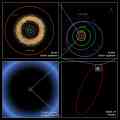Solar System -
Trans-Neptunian Objects
Beyond the orbit of Neptune there are millions, if not billions, of remote, icy, desolate objects. Most of the Trans-Neptunian Objects (TNOs) are so small and so far away that it is only with recent advances in technology that they are detectable. Of course, the most famous is Pluto, originally considered the ninth planet following its discovery in 1930. It was relegated to Dwarf Planet status in 2006, after the announcement of the discovery of Eris, a Scattered Disk Object, in 2005. Eris is more massive and slightly larger than Pluto. Pluto is really a double dwarf planet as its main moon, Charon, is more than half its diameter.
Nearly a thousand TNOs have been discovered, some of which I discuss in these sections. Four of them, Pluto, Eris, Haumea and Makemake, are considered dwarf planets, or Plutoids, and this number is likely to go up as more remote, larger objects are found. Indeed, there are already a number that are under consideration like Varuna, Sedna, Orcus and Quaoar, all of which are around 500 to 1,000 miles across. Many, like the Pluto-Charon system, are binaries, and many, again like Pluto, have several moons.
Trans-Neptunian objects are generally split into three main groups based on their orbits. Click on the item to the left for more details. There is also a section on the current NASA "New Horizons" mission to Pluto and beyond.
Nearly a thousand TNOs have been discovered, some of which I discuss in these sections. Four of them, Pluto, Eris, Haumea and Makemake, are considered dwarf planets, or Plutoids, and this number is likely to go up as more remote, larger objects are found. Indeed, there are already a number that are under consideration like Varuna, Sedna, Orcus and Quaoar, all of which are around 500 to 1,000 miles across. Many, like the Pluto-Charon system, are binaries, and many, again like Pluto, have several moons.
Trans-Neptunian objects are generally split into three main groups based on their orbits. Click on the item to the left for more details. There is also a section on the current NASA "New Horizons" mission to Pluto and beyond.
Description
Showing the relationships between the planets, the Kuiper Belt and the Oort Cloud. Sedna is, possibly, an inner Oort Cloud object. Credit: NASA/JPL/R. Hurt
Artist impressions of some of the largest TNOs. Credit.



